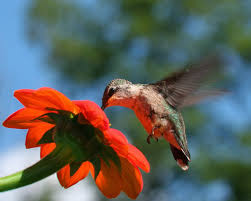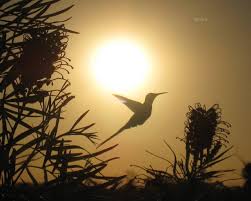Hummingbirds
by Caroline Meek
March 21, 2013
On the article from the La Paz Waterfall Gardens, Hummingbirds
and other sources.
“A flash of harmless lightning,
A mist of rainbow dyes,
The burnished sunbeams brightening
From flower to flower he flies.”
~John Bannister Tabb
The hummingbird is a bird loved by many. It is hard not to be captivated by this ‘flying jewel’ when he whizzes through the air - just like lightning! There are many things that make hummers unique and totally different from the rest of the bird population - this bird is almost unbelievable. For the smallest bird on Earth, it certainly has a lot of character.
One of the first things one would notice first about a hummingbird is its size. From tip to tail, the largest hummingbird is merely 8 inches long, weighing in at about 20 grams (about the same as a new pencil) . Even the babies of this species, called the Giant Hummingbirds, are larger than other types. The smallest species, called the Bee Hummingbird of Cuba, is in fact almost as small as a bee. With only 2.25 inches to its name, this species is not only the smallest bird, but also the smallest vertebrate! It weighs only about 2.2 grams, no more than a U.S dime. Just imagine. It seems almost impossible that a creature that small can even exist! The most common type, the Ruby-throated hummingbird, what most people are familiar with, is about 3 ½ inches - 3 grams. Just for reference, it takes over 450 grams to make a single pound. Another interesting fact: in some species, like the Ruby-throated hummers, the females can be about 20% larger than the males! Males and females are usually told apart by the differences in their throat colors and tail feathers.
In many hummingbirds, as much as 30% of their weight is in their flight muscles. These muscles definitely deserve some extra concentration, for the flight of the hummers in mind-blowing. With more range than any other aviary, the hummingbird is capable of flying forward, sideways, straight up and down - it can hover in one spot, fly backwards, and for short distances, even fly upside down! Hummers are the only birds that can fly both forwards and backwards on their own power. This incredible capability is due to the movement of their wings, a ball and socket joint, which can be rotated in a circle - 180 degrees in all directions. In flight, hummingbirds do not flap up and down, but rather in an oval-like way. When they are hovering, the motion resembles a figure-eight. In this way, they not only get power from the down stroke, like other birds, but also from the push up. Their wings seem very fragile, almost paper-thin really, but they are actually quite sturdy; they hold up under the immense pressure of the average 70 beats per minute. If you can grasp this, in a dive, the translucent wings can go up to 200 per second! The hummingbird can reach over 50 miles per hour, but the normal speed is ‘just’ 25 mph. To keep up with this lightning fast wings, the heart pumps furiously. A hummer’s heart rate can be as high as 1,260 beats per minute.
In order to compensate for the huge amount of energy being spent, the hummingbird must eat a lot. And not only a lot, but also very frequently. A hummingbird can actually starve to death in a matter of hours! For this reason, they eat about 5-8 times an hour, each being at the most about a minute. That’s like having a snack break every ten minutes! The flowers hummingbirds visit have a few specific necessary qualifications. First, they are always brightly colored, usually red. Another ingenious thing is that they prefer the flowers to have no place to land. This may seem strange, but the reason is simple - it cuts off competition from other birds, because the hummingbird is the only one that can hover! The shape of the flower matters too - hummingbirds prefer flowers shaped like trumpets - long and tubular. These thin flowers are easy for them to access - their bills are about as long as their bodies, although the length and shape varies for different species. Their tongues happen to be twice as long as their bill! Most tongues are about one or two inches long. Flower nectar is not a hummer’s only food though. In addition to the sugar, insects are consumed as a source of protein in order to build their muscles. Hummingbirds take in at least their whole body weight each day to survive - 6,000 to 12,000 calories in all. Territory is also extremely important. Hummers have incredible memory (five times larger than that of a songbird), and can remember flowers they fed off of years ago, and also various sources along their paths of migration. Every important flower in their territory is filed in their brains - they even remember how long it takes for the nectar to refill in certain flowers! Hummingbird will defend their area fiercely, fighting birds larger than they, and also other birds of their own species, diving and sometimes even stabbing the other with their bills! Some hummingbirds do migrate - many over extreme distances. One of the most impressive is the course the Rufous Hummingbird takes from Alaska to Mexico, sometimes over 10,000 miles. Also the Ruby throated - flying 500 miles over the Gulf of Mexico - non-stop, without food or rest.

One very odd thing about the hummingbird is that they can often be found sleeping upside down! This is because when they sleep, they perch on a branch and go into a state similar to hibernation, called torpor, where their heart slows considerable and they use much less energy. Otherwise, they would starve during the night for lack of food for energy. In the morning, everything goes back to the normal lightning fast pace, but in the night, their grasp on the branch is sometimes loosened, and they wake up in the morning upside down!
Did you know, that hummingbirds feet are very weak? They cannot even walk; perching and a few short hops is all they can manage. Also surprising, hummingbirds do not have a call; they just make small chirps and throat sounds. Hummingbirds have long had a place in the fantasy world - numerous stories and legends have been told of them. Perhaps the ancient people were also attracted to the magical sense of them, and how they were so unique and unlike any other creature. Many of these relate the hummingbird to rainbows and the sun. Some say the bird got its colors by flying through a rainbow. A Mayan myth believes that the hummingbird is the sun come down to earth. In whichever case, the hummingbird is always seen as mysterious and lovely; a symbol of good or healing. It is interesting to see what people thought of them so long ago.

There are many species of hummingbirds - it is the bird with the second most species in the family - around 343. For some reason, these birds are found exclusively in the American continents. Only 16 species breed in the U.S. - most of them live in tropical places - such as Colombia and Ecuador, where there are many flowers and insects. In Costa Rica, 57 species exist. At the hummingbird garden in La Paz, Costa Rica, 26 of these can be seen - it is the largest hummingbird garden there. I was amazed and glad to find this great article on the La Paz website! It is a great article with almost all the information I needed to review the hummingbirds, which are a very broad subject. To me, it also has a personal side to it; we have actually been to La Paz, and I have seen their Hummingbird garden - it is amazing! You almost want to duck because the hummingbirds are whizzing by your head so fast. And you can stand just a foot away from the feeder as the dart in and out. One almost touched me! I hope this has been an interesting article review - I am just amazed at these birds and what they can do. To me, all nature is unique in itself. But the hummingbird is a thing that goes above and beyond. It is absolutely astounding - it is like no other.
~Caroline Meek
Articles reviewed:

This is awesome!! Thank you for sharing. Hummingbirds are too cool! :)
ReplyDeleteMy goodness Caroline, you should write more articles like this! I could sudy them up, and I would be ready to get my college degree already! Amazing!!
ReplyDeleteWow thanks :) we should do that - I'll do a bunch of animals and stuff for you :) for zoo stuff and all :)
ReplyDeleteHi thanks foor sharing this
ReplyDelete